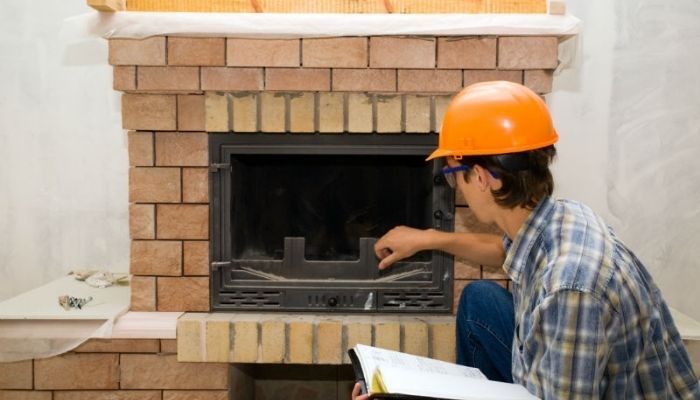Yes, gas fireplaces can cause headaches. This is because of the dangerous fumes that are produced during the combustion of fossil fuel. The main agent that causes headaches is carbon monoxide. The main byproduct of the oxidation process.
Improper maintenance of a gas fireplace can cause the incomplete combustion of fuel hence a lot of fumes in the room. Once you inhale such fumes, they take up oxygen in your blood. The low oxygen content in your brain cells is what causes headaches.
The incomplete combustion of the fuel is not a normal thing. A problem must be somewhere with the whole system. Improper maintenance is the main reason you will find high carbon monoxide in the air. This article will give you possible problems with gas fireplaces that lead to the accumulation of fumes in your home.
Possible Problems with Gas Fireplaces
Gas fireplaces are designed to produce zero fumes for the user. But once you start feeling the difference in the air you breathe then something is wrong with the whole system. Below are some of the possible problems that can cause fumes with your gas fireplace.
- The pilot light is not working
The pilot light is what ignites the whole system. This is the spark that ignites the fuel that is flowing through the system. Some gas fireplaces have a small flame as the pilot light. Open the vents and see if the flame is present. If not, use an ordinary match to light up the pilot light.
The pilot light not working is mainly caused by moisture build-up in the pipes. To correct this, go to the gas meter and find a pipe called the tee. The tee is a capped pipe that retains moisture. Just clean this pipe and the pilot problem will be over.
- Airflow and chimney problems
This mainly happens to vented gas fireplaces. This type of fireplace has a chimney. The chimney allows the hot air to rise while the cool airdrops. Once the chimney is not functioning then it means some hot air will not leave the fireplace. The hot air left behind is radiated back to the fuel lowering the fuel temperature.
This fuel with low temperature is what causes condensation and release of fumes back into the room. The imbalance of pressure in your home also causes the chimney to malfunction.
- Improper inspection and maintenance
A gas fireplace requires regular inspection and maintenance. You have to inspect the gas lines, the chimney, and any other main parts to see any possible problem.
You have to clean all the small debris and dust on the burning logs and pipes. The chimney is the main part that requires cleaning. This is the part that controls the pressure and airflow.
- Pet hair and dander accumulation
Pets like cats and dogs shed down their hair, these hairs sometimes accumulate on the burner and chimney. The situation can be bad when they suck up in the gas pipes causing a blockage. Blocked pipes are very dangerous and can lead to a fire or explosion. You are advised to regularly clean the gas logs.
- Dead batteries
Yes, a gas fireplace has batteries. There are a set of replaceable batteries at the back. These batteries power the receiver of the remote control. When your gas fireplace is not working, change the batteries in the receiver and in the remote control. And try again to power it on.
- Gas leak
This is a common problem with most gas fireplaces. And you have to be careful with this problem. Raw gas has a unique smell, it is like rotten eggs. Once you get such a smell, immediately shut down the main valve and contact the gas company. The gas company will inspect for leakage and repair where necessary.
Are Fumes from Gas Fireplaces Harmful?
Yes, they are dangerous. Carbon monoxide is the main compound in the gas fireplace fumes. It is a dangerous gas that is silent. It can cause frequent headaches and death if inhaled for a long time. You are advised to install carbon monoxide detectors in your home.
Periodic inspection and maintenance is the best way to stop your gas fireplace from producing fumes. The fumes can lead to bad conditions for people with respiratory problems and children under the age of seven.
What is a Safety Barrier on a Gas Fireplace?
An electric fireplace is the only fireplace you are allowed to touch the glass screen. Because the glass does not get hot and the flames are not real. But for the gas fireplaces, the flames are real and the glass screen gets hot.
A safety barrier is placed in front of the hot screen to prevent direct contact that may lead to serious injuries. This device is important especially if you have small children and pets in your home.
Is it Safe to Cover a Gas Fireplace?
It is not safe and illegal to cover the gas fireplace. You have to allow the fumes and other dangerous gases to go outside through the chimney. However, nowadays there are some special covers that help to filter out dangerous fumes. Such covers are allowed.
When the fireplace is turned off, you can cover it to prevent dust and debris from accumulating on some parts. Wait a few minutes for the fireplace to cool down before you cover it.
Conclusion
A well-maintained gas fireplace will not cause headaches in your home. Headaches start when fumes from the fireplace start to accumulate in your home. Such fumes are not good for human health and pets. Install fume detectors and they will help you control your gas fireplace.


